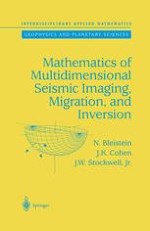2001 | Buch
Mathematics of Multidimensional Seismic Imaging, Migration, and Inversion
verfasst von: N. Bleistein, J. W. Stockwell Jr., J. K. Cohen
Verlag: Springer New York
Buchreihe : Interdisciplinary Applied Mathematics
Enthalten in: Professional Book Archive
